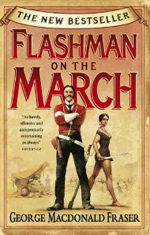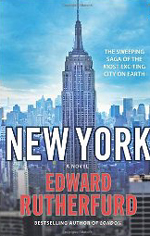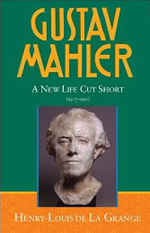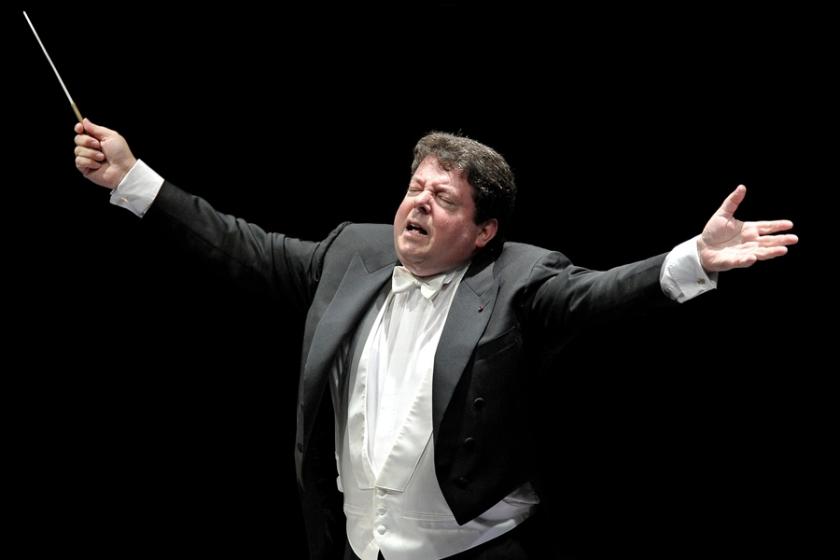Newly knighted with the Royal Norwegian Order of Merit for his services to the Bergen Philharmonic Orchestra, American conductor and pianist Andrew Litton is a musician who believes in the nurturing of long-term orchestral relationships: eight years as music director in Bergen, with the contract recently extended to 2015, and an equal length of time before that in Dallas have reaped their rewards. In May he spoke to theartsdesk while visiting Berlin with "the other" BPO, and in August conducted a three-part Prom with the Royal Philharmonic featuring works written for Boston Symphony Orchestra supremo Serge Koussevitzky. Here he discusses reading matter, musical and otherwise.
1. What are you reading for the summer at the moment?
One of the greatest gadgets to come into my life in the last couple years has been the e-book reader: Kindle and iPad.
I routinely go out on the road for six to eight weeks, and often have a whole suitcase packed just with the orchestral scores I need. Adding books to the weight load has been costly in airline overweight charges, not to mention convenience, and so my choices have been pretty much limited to biographies and non-fiction writings to aid in my studies. The joy of my iPad is that I can read two to three books at once depending on my mood and situation, all with the flick of a screen, and without looking like a library trolley! I am currently in the midst of Sibelius: A Composer's Life and the Awakening of Finland by Glenda Dawn Goss. It is proving to be a fascinating and exhaustive study in all things Finnish, not just its most cherished composer. I am finding the book particularly helpful in unravelling the mysteries of Sibelius interpretation - sometimes it takes the unbiased honesty of an outsider (Ms Goss is from the American state of Georgia) to quantify and put things into proper perspective for all of us to appreciate.
The other book I am reading comes from the Flashman series by George MacDonald Fraser. I confess to never having heard of the series before; it was recommended by one of my closest friends, and I am so glad that this omission has been rectified. It is impossible not to get drawn in to the vivid depiction of the Victorian age, so palpable that one keeps having to remind oneself that this is a novel! I shall definitely be investing in the other books in the series, but the one I quite randomly started with is Flashman on the March and it is easy to see why one critic called Flashman a Victorian James Bond.
[Excerpt from Flashman on the March by George MacDonald Fraser (HarperCollins)]
 “Half a million in silver, did you say?”
“Half a million in silver, did you say?”
“In Maria Theresa dollars. Worth a hundred thou’ in quids.”
He held up a gleaming coin, broad as a crown, with the old girl double-chinned on one side and the Austrian arms on t’other. “Dam’ disinheritin’ old bitch, what? Mind, they say she was a plum in her youth, blonde and buxom, just your sort, Flashy – "
“Ne’er mind my sort. The cash must reach this place in Africa within four weeks? And the chap who was to have escorted it is laid up in Venice with yellow jack?”
“Or the clap, or the sailor’s itch, or heaven knows what.” He spun the coin, grinning foxy-like. “You’ve changed your mind, haven’t you? You’re game to do it yourself! Good old Flash!”
“Don’t rush your fences, Speed, my boy. When’s it due to be shipped out?”
“Wednesday. Lloyd packet to Alexandria. But with Sturgess comin’ all over yellow in Venice, that won’t do, and there ain’t another Alex boat for a fortnight – far too late, and the Embassy’ll run my guts up the flagpole, as though ‘twas my fault, confound ‘em – “
“Aye, it’s hell in the diplomatic. Well, tell you what, Speed – I’ll ride guard on your dollars to Alex for you, but I ain’t waiting till Wednesday. I want to be clear of this blasted town by dawn tomorrow, so you’d best drum up a steam-launch and crew, and get your precious treasure aboard tonight – where is it just now?”
“At the station, the Strada Ferrata – but dammit, Flash, a private charter’ll cost the moon – “
“You’ve got Embassy dibs, haven’t you? Then use ‘em! The station ain’t spitting distance from the Klutsch mole, and if you get a move on you can have the gelt loaded by midnight. Heavens, man, steam craft and spaghetti sailors are ten a penny in Trieste! If you’re in such a sweat to get the dollars to Africa – “
“You may believe it! Let me see… quick run to Alex, then train to Cairo and on to Suez – no camel caravans across the desert these days, but you’ll need to hire nigger porters – “
“For which you’ll furnish me cash!”
He waved a hand. “Sturgess would’ve had to hire ‘em, anyway. At Suez one of our Navy sloops’ll take you down the Rea Sea – there are shoals of ‘em, chasin’ the slavers, and I’ll give you an Embassy order. They’ll have you at Zoola – that’s the port for Abyssinia – by the middle of February, and it can’t take above a week to get the silver up-country to this place called Attegrat. That’s where General Napier will be.”
2. What have you enjoyed reading in similar circumstances in the past?
I love novels that have a deep historical connection. Recently on the BBC Radio 3 Literary Prom in which I took part, I chose Dickens's A Tale of Two Cities as one of the five works of fiction that had a huge impact on me. In a similar historical vein, I recently finished Edward Rutherfurd's epic New York, the novel. As a born and raised New Yorker, literally from Manhattan, it was inspiring for me to follow the historical outline of my city through his tales, going all the way from 1664 and the Dutch occupation to 2009.
[Excerpt from New York by Edward Rutherfurd (Arrow Books)]
 New Amsterdam might not be large: a fort, a couple of windmills, a church with a pointed spire; there was one small attempt at a canal, more like a large ditch really, and some streets of step-gabled houses which, together with some modest orchards and allotments, were enclosed within a wall that ran from west to east across Manhattan’s southern tip. Yet it had a history. Ten years before even the Mayflower sailed, the Dutch West India Company, seeing the value of the vast natural harbour, had set up a trading post there. And now, after half a century of fits and starts, it had developed into a busy port with outlying settlements scattered for dozens of miles around – a territory which the Dutch called the New Netherland.
New Amsterdam might not be large: a fort, a couple of windmills, a church with a pointed spire; there was one small attempt at a canal, more like a large ditch really, and some streets of step-gabled houses which, together with some modest orchards and allotments, were enclosed within a wall that ran from west to east across Manhattan’s southern tip. Yet it had a history. Ten years before even the Mayflower sailed, the Dutch West India Company, seeing the value of the vast natural harbour, had set up a trading post there. And now, after half a century of fits and starts, it had developed into a busy port with outlying settlements scattered for dozens of miles around – a territory which the Dutch called the New Netherland.
It already had character. For two generations the Dutch and their neighbours, the Protestant, French-speaking Walloons, had been fighting for independence from their master, Catholic Pain. And they had won. Dutch and Walloons together had settled in New Amsterdam. It was a Walloon, Pierre Minuit – a name that was still pronounced in French, “Minwee” – who had bargained with the native Indians, four decades ago, to purchase the right to settle on Manhattan. From its birth, the tough, independent spirit of these mixed Protestant merchants had infused the place.
But above all it had position. The fort, to a soldier’s eye, might not be impressive, but it dominated the southern tip of Manhattan Island where it jutted out into the wide waters of a magnificent, sheltered harbour. It guarded the entrance to the big North River.
And Peter Stuyvesant was its ruler.
The English enemy was already close. The New England men of Massachusetts, and especially of Connecticut with their devious governor, Winthrop, were always trying to poach territory from the outlying Dutch settlements. When Stuyvesant built up the stout wall and palisade across the northern side of the town, the New Englanders were politely told: “The wall is to keep the Indians out.” But nobody was fooled. The wall was to keep out the English.
3. What are you looking forward to reading?
I am eagerly anticipating starting Volume 4 of Henry-Louis de la Grange's Gustav Mahler: Volume 4: A New Life Cut Short. This greatest of all Mahler biographers has given us the definitive study of one of my favourite composers. Mahler the conductor was the first of his kind and influenced the development of the modern conductor from Bernstein to Dudamel. This volume covers Mahler's final years and his time on the podiums of New York. It won't be in my suitcase anytime soon though, since it is almost 1800 pages! Now if only they would put it on Kindle...
[Excerpt from Gustav Mahler: Volume 4: A New Life Cut Short by Henry-Louis de la Grange (OUP Oxford)]
 In the early years of the 20th century, everything concerning the New World, and particularly New York, was already a matter of intense interest to Europeans. Mahler had numerous friends and acquaintances who had visited the United States, including Richard Strauss, Franz Schalk, Lilli Lehmann, Moriz Rosenthal, and Gerhard Hauptmann, and he must certainly have questioned them about their experiences. But the picture he obtained from them concerning that distant world was doubtless a confusing one. So Mahler’s emotions on leaving Vienna were surely divided: on the one hand, he could feel satisfaction at leaving behind a country which had shown itself unable to appreciate his true value; on the other, there must have been quite a considerable degree of apprehension as he contemplated such a huge new challenge. The European perception of America was largely one of a continent where money was omnipotent, enterprise untrammeled, and advertising deafening. Beyond that, it was a place where virtuosos hogged the limelight: Mahler would scarcely have contemplated becoming a star in the American style, but how else would he have a hope of succeeding in a society which was said to be a desert of ignorance and philistinism?
In the early years of the 20th century, everything concerning the New World, and particularly New York, was already a matter of intense interest to Europeans. Mahler had numerous friends and acquaintances who had visited the United States, including Richard Strauss, Franz Schalk, Lilli Lehmann, Moriz Rosenthal, and Gerhard Hauptmann, and he must certainly have questioned them about their experiences. But the picture he obtained from them concerning that distant world was doubtless a confusing one. So Mahler’s emotions on leaving Vienna were surely divided: on the one hand, he could feel satisfaction at leaving behind a country which had shown itself unable to appreciate his true value; on the other, there must have been quite a considerable degree of apprehension as he contemplated such a huge new challenge. The European perception of America was largely one of a continent where money was omnipotent, enterprise untrammeled, and advertising deafening. Beyond that, it was a place where virtuosos hogged the limelight: Mahler would scarcely have contemplated becoming a star in the American style, but how else would he have a hope of succeeding in a society which was said to be a desert of ignorance and philistinism?
We now have evidence that Mahler’s interest in America may have begun a whole decade before he first crossed the ocean. As early as 1887 one of his letters mentions an offer received from a New York agent to replace Anton Seidl, no doubt at the Metropolitan Opera. What is more, Mahler is clearly taking the offer seriously. Later on, in a letter he wrote to his friend Lilli Lehmann, who had sung no less than 260 performances at the Met, he mentions a second proposal had come his way. The letter which refers to it is undated, but Zoltán Roman compared it with a much later one (1907) addressed to Mahler by the impresario Charles Löwenstein. Roman concluded that the first letter mentioned above must have been written after Anton Seidl’s death, which occurred on 28 March 1998, and that it refers to Löwenstein’s proposal that Mahler should direct the National Conservatory of Music (a position left vacant since Anton Dvořák’s departure in 1895) and conduct 50 concerts per season in New York. What is particularly surprising is that Mahler should seriously have considered accepting such an offer only two years after being appointed to the directorship of the Vienna Opera, a position that he had only managed to achieve after a long struggle over many years.















Add comment